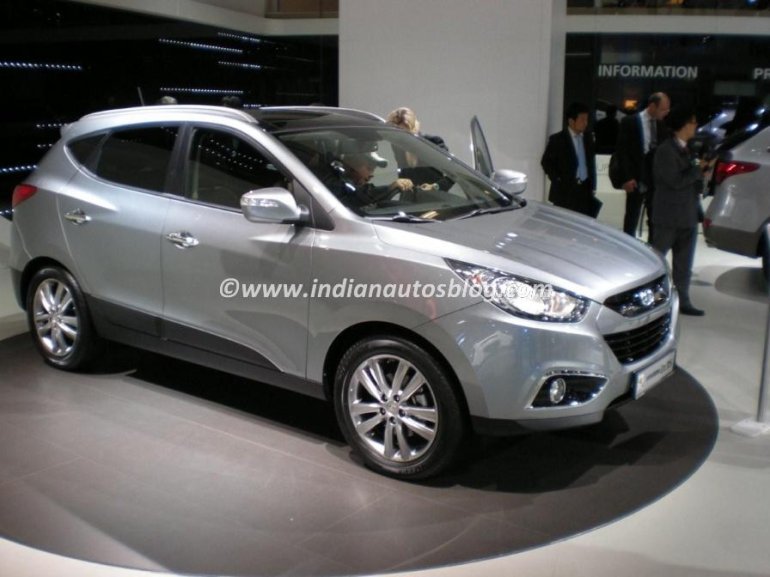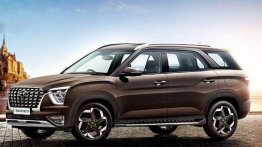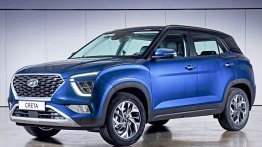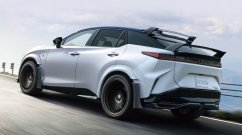The Hyundai ix35/Tucson with more lines on its body than a Bengal Tiger, is casting spells at the Hyundai stall in this year's Frankfurt Motor Show. It bears no resemblance to the outgoing model, indicating its strong departure, despite the model occupying the top slot in terms of sales in Europe's SUV category.
We've shown you enough spy shots and renderings of the next generation Tucson, so its time to enjoy exclusive images brought to you right from the show.
And don't forget to check out the press release after the break which is loaded with all the information regarding the vehicle.
Images clicked and sent in by Gustavo Ruffo of Motor Dicas and Motor Tips
Press Release
| CONCEPT
After Tucson's successful long run, the challenge of the EL project team was to conceive an even better C- SUV than the already great original. Starting with a clean slate, the LE development team moved away from the two-box off-roader look in favor of a sleeker, more reformed profile while aiming for a roomier cabin, extra storage capacity and fuel economy leadership. STYLING CONFIDENCE Hyundai's new "fluidic" design language finds confident expression in the sweeping, gently curved lines of the ix35. The hexagonal grille previewed on the ix-onic concept at the 2009 Geneva Auto Salon moves into mass production on the ix35, a defining look that will serve to unify the family of future Hyundai products. To achieve the desired dynamic and sporty image, ix35 gets an aggressive belt line coupled with a low-to-the-ground feel which is enhanced by the optional 225/55 R18 wheels. Aerodynamic tweaks include the addition of a rear spoiler which aids fuel efficiency. The interior lines echo the dynamic flow of the sheet metal. For improved comfort, designers have managed to carve out extra legroom and headroom (whilst lowering the overall height of the vehicle). The feeling of spaciousness in the cabin is further enhanced by the new dual-panel panoramic sunroof with UV blocking. Rear seat passengers now get to share the enjoyment of a sunroof too. The center panel can either tilt open or can open completely by sliding up and over the rear panel. An anti-pinch system guards against injuries from trapping. The gauge cluster borrows Supervision technology from the Genesis luxury sedan to display key information with crystal-clear clarity and minimal eye stress. All instruments and gauges are backlit in Hyundai's signature blue color which is being applied across the range. OVERALL DIMENSIONS The ix35 rides on a 2640mm wheelbase which is just 10mm longer than the previous iteration. At 4410mm and 1820mm, it is also longer and wider than its predecessor (by 85mm and 20mm, respectively) greatly improving the interior cabin space but the overall height of 1660mm has been lowered by 20mm without affecting headroom. Greater travel in the front seat adjustment gives more legroom and headroom for taller drivers. The centre console box has been enlarged to 6.2 litres (an increase of 3.4 litres) for more storage and the centre armrest is longer and higher for greater comfort. The USB/Aux jack has been relocated to create more storage space for personal music players. In addition, the height of the rear cargo screen has been raised by 71mm for more storage plus a small storage binnacle has been added in the rear cargo area. POWERTRAIN To further broaden its appeal, ix35 will get the newest fuel-efficient engines and six-speed manual and automatic transmissions. Powertrain availability will vary according to region. Western European customers will be offered a choice of two thrifty and clean-burning petrol engines: the Theta-II 2.0 rated at 163ps and 20.1kg.m of torque which emits just 178g/km of CO2 (2WD MT) and the Gamma 1.6 GDI delivering 140ps and 17kg.m of torque, available from November 2010, which delivers only 159g/km of CO2. This 1.6 GDI engine will be available with ISG stop-start technology, further reducing CO2 to just 149g/km. The European diesel lineup includes two all-new engines: the R 2.0 and the U-II 1.7, which will be available from November 2010. The R 2.0 will come in a choice of two outputs: high (184ps/40kg.m) and low (136ps/32.6kg.m) producing CO2 emissions of just 165g/km (4WD MT), and 158g/km (2WD MT), respectively. The U-II will have a rated output of 115ps with 26.0kg.m and will have class-leading CO2 emissions of just 139g/km when equipped with ISG (2WD MT). Six-speed manuals are standard with both diesels while the R will come with the option of a six-speed automatic. The R 2-liter diesel will also be offered in markets outside of Europe (excluding North America). For the North American market, where EL will be known as Tucson ix, a choice of Theta-II engines –: the 2-liter or 2.4-liter – will be available. THETA-II Hyundai engineers have taken the World Engine, the largest gasoline engine program in the world, and created the lighter, more fuel efficient and cleaner-running Theta-II. The 2.0-liter Theta-II has shed over 10kg from its previous iteration. For better fuel efficiency and reduced NOx emissions, Theta-II gets Dual CVVT (intake and exhaust camshaft phaser) while Theta-I is equipped with only intake CVVT. Major improvements begin with the application of a two-stage Variable Intake System (VIS) which enables switching between long and short intake manifold resulting in an across-the-board performance increase. To reduce internal friction, engineers have applied a Diamond-like-coating (DLC) to the top surface of the valve tappets resulting in improved fuel efficiency. Engineers also expended considerable time and effort optimizing the oil pump pressure to achieve an ideal balance between durability and fuel economy. R DIESEL ENGINE The R is the newest member of Hyundai's passenger diesel family joining the U (1.1, 1.4 and 1.6–liter), the A (2.5–liter) and S (3.0–liter V6). In its initial 2-liter edition, R generates 184ps and 40kg.m of torque. The R–Engine benefits from the third generation common rail system developed by Bosch whose piezo-electric injectors deliver fuel at 1800 bar providing an unprecedented degree of accuracy and control. It also features an electronically-controlled variable geometry turbocharger and an advanced engine control unit (air system-based charge control). The R–Engine is fitted with a 16-valve dual overhead camshaft which is driven by an internal steel silent timing chain. For reduced vibration and lower booming noise, the R gets a lower balance shaft which has been encased in a stiffened ladder frame housing for increased rigidity. Weight-saving features include serpentine belt with isolation pulley, a plastic head cover, plastic intake manifold and plastic oil filter housing. Developed by a 150-man team at an investment cost of 250 billion won, the R–Engine harnesses Hyundai´s newest and most advanced development tools. Computational flow dynamics and structural and thermal analysis were used to optimize its design while computerized simulation of the die casting process was employed to achieve the optimal balance of strength and low weight. Over 500 prototype engines were built during the 42 month–long development period which encompassed a wide variety of performance and emissions tests, endurance as well as NVH, cooling and lubrication studies. Finally, the engine was installed in vehicles and subjected to exhaustive testing under all imaginable environmental conditions. To achieve Euro-5 emission compliance, the R is fitted with a close-coupled diesel particulate filter plus highly efficient exhaust gas recirculation with by-pass valve. The second-generation U-II 1.7-liter engine will also be available mated to a six-speed manual in the basic version SIX-SPEED AUTOMATIC Hyundai's all-new six-speed automatic transaxle helps the company meet its goals of improving fuel efficiency and reducing CO2 emissions. Shifts are silky-smooth with an option of sporty-type, manual shifting through the Shiftronic which is also new to the ix35. Designed for transverse engine applications in passenger cars and SUVs, the new compact transaxle puts Hyundai into an elite class of auto manufacturers who have designed their own proprietary 6-speed automatic (after Toyota and a GM/Ford joint venture) demonstrating Hyundai’s advanced powertrain engineering capabilities. The strength of the design is its totally unique layout which makes it smaller, more compact and lighter than any other 6-speed on the market today. For the customer, the new six-speed promises a performance edge. In this application, it delivers a 12.2 percent gain in fuel economy (10.1km/l versus 9.0km/l) and is 2.5 percent quicker in zero to 100km/h acceleration times (7.8sec versus 8.0 sec). It also delivers an 11 percent improvement in 60km/h to 100km/h overtaking performance (4.0 sec versus 4.5 sec). Furthermore the unit is maintenance-free: the gearbox is not equipped with a dipstick as it is filled with an automatic transmission fluid that is good for the life of the vehicle thereby reducing maintenance costs. Developed over a four-year period, this new six-speed automatic is 12kg lighter than the five-speed it replaces. It also is 41mm shorter and considerably simpler having 62 fewer parts, which is a key to increased durability, lighter weight and lower cost. When it comes to gearsets, more is definitely better. The addition of a sixth gear enables closer spacing between gear ratios providing a better balance of performance and fuel economy while the wide overall gear ratio helps deliver strong acceleration. The gearbox has three planetary gearsets whose hallmark is simplicity of design and a unique flat torque converter which shortens the unit's overall length by 12mm. Four pinion differentials improve durability and further minimize size. Another example of engineering ingenuity is to be found in the design of the hydraulic pressure control unit. Because there are always slight manufacturing deviations from one solenoid valve to the next which cause fluctuation in the hydraulic pressure and affect shift precision and quality, the transaxle features cleverly integrated adjustment screws in the valves which enable each of the eight valves to be calibrated at the factory. This novel feature ensures stable hydraulic pressure at any shift point which facilitates a high degree of precision and control needed to deliver ultra-fast, smooth and precise shifts throughout the rpm range. FUEL ECONOMY INNOVATIONS In addition to the new fuel-efficient engines and transmissions, the ix35 features a number of other innovations which contribute to lower operational costs. Nestled between the speedometer and tachometer, the "ECO" coach is a new feature designed to promote fuel-saving driving habits. In the manual transmission version, an icon on the LCD tripometer screen begins to flash when the optimum gear shift point is reached. The automatic uses an "ECO" icon backlit by LEDs with either the red, white or green LED lighting up in accordance with driving behavior. Fuel savings in the range of 15 to 17 percent are attainable with the automatic "ECO" coach and 7 to 9 percent with the manual. ix35 features a state-of-the-art Alternator Management System (AMS) whose circuitry monitors electrical loads and the state of battery charge. During periods of low electrical loads and a full charge in the battery, a clutch automatically disengages the alternator thus reducing the load on the engine and lowering fuel consumption. Further gains in fuel efficiency have been realized by specifying a motor-driven power steering system which delivers excellent responsiveness and accurate handling. Also, V-Let low-rolling resistance tires are available. SUSPENSION The multi-link rear suspension was adopted not only for its superior ride and handling characteristics but also because of its compact design which minimizes intrusion into the cabin creating extra space for passengers and cargo. Tried and true MacPherson struts are employed for the front suspension set-up. SAFETY INNOVATIONS The body shell structure is engineered to the very highest standards of safety: In crash safety tests conducted in-house ix35 scores a five-star rating in Euro NCAP testing for both frontal and side impacts. Particular attention has been paid to increasing the stiffness of the front side members which have been enlarged and straightened. Also, the center pillars serve as the anchors of new ring structure which improves overall side structure stiffness while also creating more room for the door armrest and seat. The entire body shell has been made stiffer and lighter thanks to its more extensive use of ultra-high tensile strength steel which comprises 68.9 percent of the shell compared to its predecessor's 57.3 percent. Also, the use of Tailor Welded Blanks has been expanded on key structural members. TWB assemblies combine steels of different thickness and grades using a sophisticated laser welding and stamping process achieving an optimal stiffness-to-weight ratio. TWBs reduce body weight while enhancing crash energy management. Extensive work was done to isolate sounds and eliminate vibrations. ix35 is discernibly quieter both at highway speeds and at engine idle. Booming noise is reduced thanks to a sub-frame dynamic damper while the rear luggage area gets extra soundproofing to isolate exhaust sounds. Road noise has been minimized by improving stiffness in the front and rear struts, rear trailing arm and the spring sheet. In a panic braking situation, the emergency flash signals are automatically triggered thus reducing the risk of rear-end crashes. In the unfortunate event of a rear-end collision, active headrests are triggered by the pressure of the seat occupant’s weight on the backrest, the headrests automatically moving upwards and forwards to help prevent injuries to head, neck and upper body. In addition to 4WD capability (optional), ix35's CUV credentials are strengthened with two new safety features: Hillstart Assist Control and Downhill Brake Control which promote safer travel up and down steep slopes. For safer maneuvering in reverse gear, a rear-view camera has been added. Shifting into reverse gear automatically turns on the rear-view camera which provides a wide-angle view of the rear on a 3.5-inch color LCD built into the rear-view mirror thus reducing the risk of accidents. The rear-view mirror is autochromic which means it automatically dims during night-time driving to reduce the glare of the headlights from vehicles behind. A Smart-Parking Assist System uses the rear-view camera to provide a graphical grid overlay to safely guide the driver into the parking spot. Elongated flush-mounted headlamps not only add a strong sense of style but also feature projector beam lenses for improved night-time driving safety. Side mirror housings have been modified to reduce wind noise and also feature an integrated repeater lamp for improved visibility. At the flick of a switch, the foldable mirror housings dip inwards to reduce the overall width of the vehicle. Innovations extend to the side glass weather-stripping which now features a water dam. This not only enlarges the side glass view but also safely channels rain water to maximize visibility. COMFORT and CONVENIENCE Anti-pinching power window (driver's seat only) and rain-sensing wipers (Europe only) provide an extra touch of safety. Even the wiper blades have aerodynamic fins to increase downward pressure for improved wiping efficiency while reducing air turbulence and noise. European customers will also be able to choose a built-in navigation system. The Heating Ventilation and Air Conditioning (HVAC) system has been upgraded with a new blower and dual temperature controls for the driver and front passenger. Winter or summer, the desired cabin temperature can be reached quicker with the new air blower. The new design draws on a mix of outside/inside air for faster cooling down and warming up. The automatic control of the temperature has been made more precise thanks to the use of new and improved sensors. A cluster ionizer has also been included to combat the build-up of mildew and fungus which cause unpleasant musty odors. It generates ion plasma that ensures the HVAC system blows the cleanest, freshest air throughout the life of the vehicle. Other new features include: +Push button start with smart-key proximity sensor +Manual tilt and telescopic steering wheel +Steering wheel-mounted audio remote control +Air-conditioned, cooled glove box +Low rolling resistance tires for 16” wheels COLOURS Grey Silk, Shannon Green, Pebble Beach (Chiffon Grey) and Brueghel Brown (Mica Metallic Cool Brown) are new to the ix35 exterior palette. The interior color scheme consists of Black mono, Beige two-tone and Black monotone with Brown Seats. AVAILABILITY The ix35 will be built in three factories on two continents. Mass production of the Tucson has already started at the Ulsan factory for the Korean domestic market in September. In Nov. 2009, the Ulsan plant will begin production for North America and the general market (all countries outside of EU and greater Europe). The Kia Motors factory in Zilina, Slovakia will build the ix35 starting in the first quarter of 2010 (R engine and Theta-II) and greater Europe in the second quarter of 2010. The ix35 will also be built by Beijing Hyundai to meet demand in China. |


















